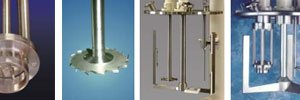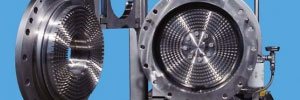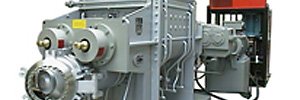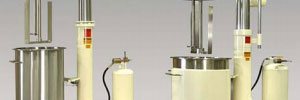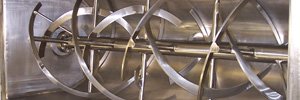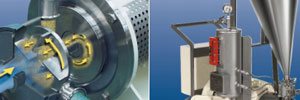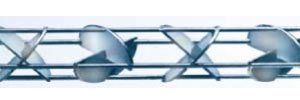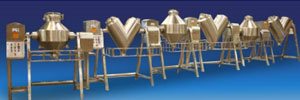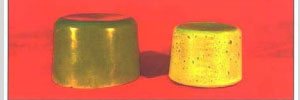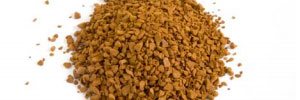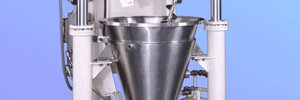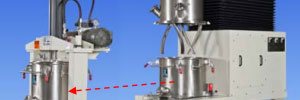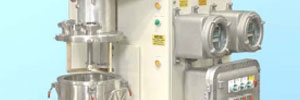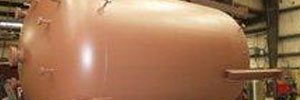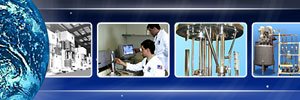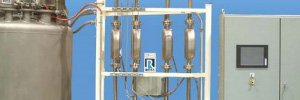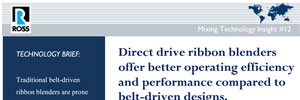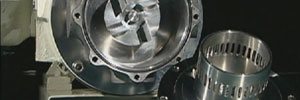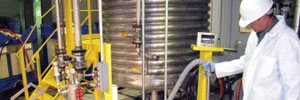Mixing Technology Insights
Mixing Technology Insights offer a brief look into ROSS' products, process expertise and market strengths. The reports delve into how the equipment can be used to improve your process and to add to your bottom line. ROSS strives to provide its customers with up to date information covering new technology in the industrial mixing and blending industry.
Select a specific product, process or market to view a list of related Insights:
Select Product
Select Process
Select Industry
- Recommended Mixing Equipment for Gel Coats
Gel coats (or gelcoats) are modified resins applied to molds in the manufacture of fiber-reinforced plastics. - Recommended Mixing Equipment for Bulk Molding Compounds
Proper mixing is critical in achieving the desired physical properties in the final molded product. This bulletin discusses the benefits of preparing Bulk Molding Compounds in a well-designed Double Planetary Mixer. - Recommended Mixing Equipment for Graphite Dispersions
Graphite, a highly conductive crystalline form of carbon, is used in a wide range of products, from batteries, heat sinks and solar cells to coatings, lubricants and composites. - Recommended Blending & Drying Equipment for Nylon Pellets
Nylon pellets are commonly blended with other plastics, coated with a powdered lubricant or mixed with concentrated pigments and other additives. - Recommended Mixing Equipment for Polyester based composites
Polyester is one of the most commonly utilized resins in the manufacture of inexpensive yet high-performance composites and coatings. Automotive and marine fiberglass parts, building panels, junction boxes, sporting goods, body fillers, fairing putties and other polyester-based products are essentially resins intimately mixed with reinforcing agents, pigments, fillers and/or additives to achieve a specific set of physical and chemical characteristics. - Recommended Mixing Equipment for Plastic Resins
Drying is an important operation in plastics production because excessive moisture in the starting resin material can result in visual defects, lower strength and reduced performance of the finished part. - How to increase shear without sacrificing throughput
Ultra-high shear mixers are ideal for homogenization, emulsification and solubilization requirements where particle or droplet size is critical. These devices are as simple to operate as regular rotor/stator mixers but are capable of intense hear levels as well as high pumping rates. - Improve your extrusion process with a static mixer.
Interfacial Surface Generator (ISG) Static Mixers are particularly ideal for use in injection molding and extrusion applications. Benefits include uniform temperature and viscosity, accurate composition and highly repeatable quality of the finished product. - Mixing Thermoplastics
The mixing of thermoplastic materials requires precise temperature control, sufficient shear and efficient agitation. This bulletin outlines some useful considerations for mixer selection. - Proper mixing of hollow
microspheres
Hollow microspheres are added to various materials to reduce weight and improve strength but in their dry form, these fillers present a mixing challenge due to their tendency to break under high shear conditions. Selecting the suitable mixer for a particular application is based on the viscosity of the liquid vehicle and the crush strength of the microspheres. Batch and continuous mixing solutions are discussed in this bulletin. - Buying reconditioned mixing
equipment
When properly restored to perfect working condition, ideally by the OEM, a reconditioned mixer or blender is comparable, if not equal, in efficiency to new equipment. The savings in cost and faster shipment help you get to the profitable stage sooner without sacrificing reliability. - Asking the right questions
about vertical blenders
When in the market for a new vertical blender, knowing what questions to ask will help you select the best equipment features that suit your specific application and properly compare offerings from different suppliers.. - Polymer grinding and
disintegration
High shear rotor/stator mixers are ideal for many polymer dispersion and dissolution processes. Different configurations are available depending on the application requirements. These include batch and inline designs, multi-agitator systems for high viscosity formulations, and even special ultra-high shear rotor/stator geometries that deliver faster polymer disintegration and more intense mixing. - High-torque, low impact
mixing of viscous composites
Double planetary mixers provide thorough, low impact agitation ideal for intimate mixing of delicate fillers into high viscosity materials. - Mixing abrasive pastes and
slurries
Dispersion of abrasive solids into liquid can be accomplished in single-shaft, multi-shaft or planetary mixers, depending on product rheology and degree of abrasion. This bulletin discusses some strategies for combating abrasive wear in these types of mixers. - Inline mixing of gases and liquids
Efficient mixing of gases and liquids is a critical step in many chemical and biological process technologies. Static mixers and inline rotor/stator mixers are typically used in gas-liquid applications where high intensity mixing, short contact time and/or continuous processing are required. - Mixing dilatant materials
Dilatant materials pose a unique mixing challenge due to their very nature: the greater the shear forces applied to the material, the more resistance is encountered. Heavy-duty, high-torque double planetary mixers operated under comparatively low speeds are ideal for processing shear-thickening mixtures. - Effectively disperse fibers into your viscous mix.
Many fiber-filled composites are high viscosity formulations that require efficient dispersion in a planetary mixer configuration where a number of blade designs and combinations are available. Fiber characteristics and composite rheology are the main factors evaluated in the mixer selection process. - Benefits and techniques of
vacuum mixing.
Mixing under vacuum offers numerous benefits including elimination of unsightly voids in the finished product, improvement of dispersion quality, degassing, enhanced drying at lower temperatures and sub-surface addition of raw materials. Fine-tuning vacuum mixing techniques leads to the optimization of these benefits. - Ribbon blenders are ideal for coating and mixing processes.
Solid-solid mixing sometimes involves powders that need to be uniformly coated with smaller particles of a different component. The ingredient that is coated onto the bulk material is typically a very small percentage of the batch, thus requiring thorough and uniform blending. Ribbon blenders are proven to be highly effective for these coating and mixing operations. - High speed mixing: saw-tooth dispersers vs. rotor/stator mixers
The saw-tooth disperser and rotor/stator mixer are two of the most widely used high speed mixers yet many are unaware of the differences in their utility and operating capacities. Knowing the unique attributes of these devices is important in mixer selection and process optimization. - Consider the advantages and disadvantages of scrapers.
Consider the advantages and disadvantages of scrapers.
The use of scrapers in batch mixing operations helps improve product homogeneity and heat transfer efficiency. However, there are cases wherein scrapers are not recommended such as in the processing of abrasive applications or highly viscous, sticky materials. - Vertical blender/dryers deliver high drying rates with negligible risk of product attrition.
Vertical blender/dryers designed for vacuum operation offer a better alternative to non-agitated dryers such as ovens and tray dryers, delivering significantly higher drying rates per unit heating area. Vertical blender/dryers can also handle a variety of feed forms including slurries and pastes which other types of agitated dryers cannot accommodate. Finally, the gentle mixing action supplied by a vertical blender/dryer minimizes product attrition which is a concern in some applications. - Double planetary mixers are ideal for low shear processing of viscous materials.
Viscous products possessing shear-sensitive behavior, fragile components or abrasive properties require gentle but thorough mixing. In most cases, a double planetary mixer is the best choice for processing such applications.

